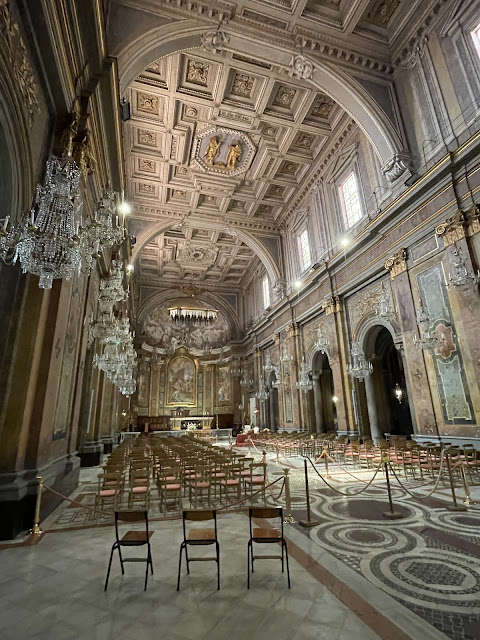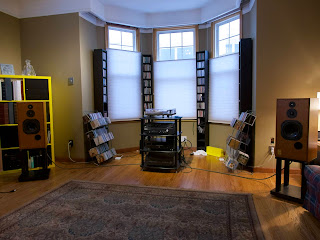The Slow Movement
The image above is the interior of the Basilica of Saints John and Paul on the Coelian Hill. The lines here were not 3 hours and yet it is filled with beauty and stories eloquent more than enough to feed our lives.
There has been a slow food movement for a long time now, with the idea that food that is produced with care locally has a healthier stamp on the planet and often in our guts too.
Back home in Toronto I've noticed the proliferation of headphones, often the in-ear type being worn on the streets with some signs of lesser attentiveness to surroundings that such accoutrements can facilitate. I've necessarily seen too much of people bumping into one another but I've seen more than one near miss with a vehicle. Refreshingly, here people seem to be more interested in or are able to be more directly sociable with one another.
I've been visiting Rome through the years since 1996 when I had my first encounter with the Eternal City. It was dirtier and arguably traffic was more chaotic than you see it now. I visited in 2003, 2007, 2016 and 2017, before coming this year. 2003 saw a big cleanup which largely happened ahead of the Jubilee of the The Third Millennium of Christianity. The other years I was at conferences and doing a pilgrimage with a short stint in Rome. So, this year I've had a chance to drink in the city as I did when I first came in '96.
The big change this time has to do with numbers and organization. The internet has made many of us experts about where we want to go and what we want to see.
And therein lies part of the problem. The city now feels almost dominated by tourists who come for very short stays, one, two or three days. This puts pressure on the expected highlight places. The lineup to see St. Peter's routinely stretches to 3 to 4 hours. Sidewalks are full of tour groups being led around and then to their buses. Signs of hospitality fatigue are certainly there. Most restaurants are for tourists with nearly identical menus and varying levels of hospitality and professionalism. And it is understandable. How many of these workers have to commute long distances into Rome or live in small quarters to be able to work long hours serving people they will never see again?
At the Forum, the Vatican, the Trevi fountain (which is in a very small square), the Spanish Steps, selfies rule.
These documents of existential presence perhaps say too much about the experience. The place is the thing. What about the people who provide the opportunity?Rome is a crossroads not only of tourists from many places, and of Romans, but also of immigrants, students, government workers and international organizations. One can hardly walk down a street or through a park and not see the evidence.
And from a religious point of view, there are so many other real treasures that are not at the Vatican or even in art museums. For a Catholic with a devotion to some of our best known saints there are Roman connections for many of them.
At the Forum I struck up a conversation with a young student from Ghana who is studying history and connected to a UN organization. As he stood in the Forum he remarked not simply on the magnificence of the building achievements of the Romans, but he wondered aloud what the human cost had been. How many people had lost their lives raising tons of stone? He wasn't far off. It was the vast slave population that made it possible for the elites to construct these monuments.
We might ask how much has this changed?
But that isn't the only point. The social context, the relationships by which things happen tell us myriads of human stories . . . if we slow down. And that's the common thread that ties us all together. We all need attention. It is the atom of real love.
In North America we seem to be obsessed about being on the "leading edge". With the complexities of geopolitics and truly awesome tech like AI, these days perhaps we need more of something else. The alternative is not standing still or becoming indifferent. The alternative is to become engaged in a way that is thoughtful and fits inside our own skin so that we can contribute something of substance to a world that is so artificially hectic.
And this is true in our spiritual and faith lives as well. Even our prayer cannot be informed without time for reflection, input and the possibility that we will have to let go of some of our self-deceptions. This should make us want to learn from others. In the other, I do find Christ. It can be perplexing, frustrating. But it is Christ who tells us even to love our enemies.
This city is visibly filled with more layers of history and threads of spirituality than one can find most anywhere else. I've spent a few months here if you accumulate my time since my first visit and I'd like to say to prospective visitors: You need at least a week! Put up with the crowded streets. Walk. Get off the beaten track. Pick a few spots you've researched because they are your favourites. Maybe we can start a Slow Move Movement!
Today's treat for me was visiting the church referred to simply as Il Gésu. It is the principal church of the Society of Jesus, the Jesuits. And my discoveries today was a chapel devoted to St. Francis Xavier who was in that first generation of the Society and who pioneered an enculturated approach to proclaiming the Gospel and the tomb of Fr. Pedro Arrupé, the Jesuit General when I was a young man, a very humble leader of the Society. I also found in another church in Trastevere the tomb of Cardinal Van Thuan who had endured years of imprisonment by the Communist government of Vietnam, and who, if memory, serves was initially named a cardinal "in pectore" by Pope John Paul II. That means his name was kept a secret. Only after he was released did his title become a matter of public knowledge.
It won't surprise you that neither of these churches was crowded . . . and there was even enough quiet to pray for a while at each.
This might even have things to say about how we regard our own history. We so easily knock buildings down and start over. We sometimes do banner projects, but the hidden jewels are what make history real and alive, and a bit more democratic as well.
In the Gospel life we are told to become good soil. That takes healthy biodiversity, many sources to come to know the one love of God. And for artists this is the same. Very often their lives are complex and even unwieldy, partly because they have the capacity to take in so much reality. It can overwhelm theme at times. In art and music, as in life, there is no warranty program. Sometimes that all leads to opaque art, but sometimes as well it contributes significantly to great art that breaks through all that complicating business of life.
And maybe that crystalline experience is what so many of us are seeking and hoping we can somehow capture with our phones.


